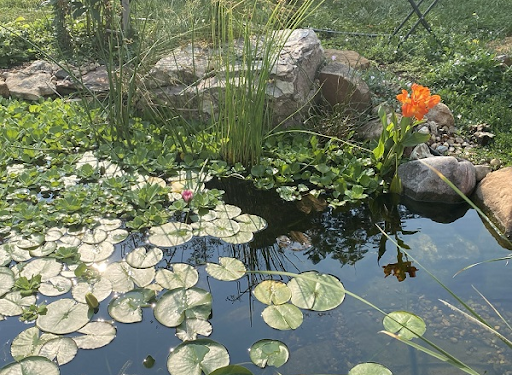
Did you know that September 22nd was the first day of fall? It was! The temperatures have gotten colder at night, but it’s still nice and warm in the daytime. The leaves have begun to change and the morning dew has returned. The days have gotten shorter and the nights are darker. All the signs that fall is upon us are appearing! It’s the time of year to take care of your pond so it stays healthy for the winter and gets a leg up come springtime.
If you don’t properly prepare your pond now, organic material left in the pond over the cold season can cause winter algae blooms, which can throw the ecosystem off balance and negatively affect the fish. As the plants go dormant for the winter, they cease to process nutrients in the water. While the fish produce less ammonia, leaves and other debris slowly break down over the winter without the plants helping to break them down.
Here are 10 things you can do to get your pond ready for fall:
1. Trim the plants
- Remove all floating plants
- Clip plants down to 4 inches above the base of the plant
- Make sure all water lily pots are at least 24 inches down. They can be moved to the lowest part of the pond for the winter, but make sure the fish are not being crowded out.
- Cut back lilies once the leaves have turned brown.
- Prune plants that may be growing outside of the pond but are hanging over it.
2. Net the pond!
There are a couple different ways to put up a net over the pond. Here are some things to know:
- A small pond can be netted using a dome made of PVC. The PVC will hold up through the weather best if it is put onto rebar that is stuck in the ground just outside the liner. While sticking it between rocks works for a bit, if it snows the weight will easily pop it back out.
- A larger pond can be netted using stakes and rope. Make sure to secure the sides with large rocks. Small ones will be pulled in by the weight of snow.
- Make sure to net BEFORE the leaves start falling and don’t leave it on all winter.
3. Bring in equipment like the Autodose and IonGen
They don’t hold up well if left out all winter. See our blog on Should Your Pond Equipment Be Out In the Weather? No! for more info on how to protect your electrical equipment.
4. Make sure all electrical equipment is covered
Another reason to check out our blog on Should Your Pond Equipment Be Out In the Weather? No! is for the links to our friends at The Pond Guy and True Pump. They can help you find some artificial landscape rocks and stumps to cover and protect your electrical equipment.
5. Switch from regular to cold water bacteria
When the temperature drops below 50 degrees, you’re going to need to switch from regular to cold water bacteria. Try The Pond Guy or True Pump.
6. Bring liquid bacteria into the house or a garage where it won’t freeze
7. Remove debris from the pond
Try to net out any debris you can see. If leaves manage to get through the net, make sure to remove them.
8. Check your skimmer basket often!
The more trees you have nearby, the more likely it is that leaves will clog up the skimmer basket or net. Clean it out as often as you can. (And did we mention putting up that net?!)
9. Remember to slow down feeding the fish as we go into the fall
Starting now, give those fish a little bit less. Pay attention to how much they are eating and only give enough so they finish it within a few minutes. Switching to fall food helps, too. It has a lower protein content and is easier to digest. Once the water temperatures reach 50 degrees you need to stop feeding them for the winter.
10. Watch the water level
Remember that if you have an Autofill, it will no longer be filling up the pond when water gets low. Perhaps there has been water loss that has gone unnoticed. It will be noticed now. If the water level in the pond is going down more than two to three inches in one week, there could be a lower liner somewhere. Fix this before winter hits!
Pro Tips:
- If there are smaller leaves that get through the net, double the net over to create smaller spaces for them to get through.
- Keep an eye on the net. Sometimes small birds will get caught in them. Set them free!
- Keep a hose somewhere in the house so that if the pond needs more water when it is really cold, you won’t have to deal with a frozen hose!
- If you are putting in stakes for a net, never put them inside the liner!
- Take care when trimming plants. Causing a leak by nicking the liner would be no fun!
Most importantly, if you have any questions about your backyard pond or water feature, contact us at Colorado Pond Pros today! Pond installation and pump repair are our business and we’d be happy to help!
And be sure to check out this helpful info on-
How to Clean Out Your Pond Pump
10 Things You Need to Know if You Just Got a Pond
